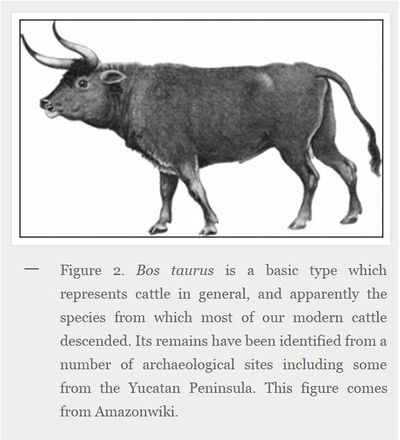
FAIR is a non-profit organization dedicated to providing well-documented answers to criticisms of the doctrine, practice, and history of The Church of Jesus Christ of Latter-day Saints.
(→Miller and Roper: "Bones of domesticated cattle...have been reported from different caves in the Yucatan Peninsula of Mexico") |
|||
| Line 9: | Line 9: | ||
Bones of domesticated cattle (Bos taurus – see Figure 2) have been reported from different caves in the Yucatan Peninsula of Mexico.<ref>Robert T. Hatt, “Faunal and archaeological researches in Yucatan caves.” ''Cranbrook Institute of Science'' 33 (1953), 1-42.</ref> In one instance these bones were found with those of an extinct horse, Equus conversidens. It is especially interesting that along with these cow and horse remains, human artifacts were found in association with them! The indication is that domesticated cattle and the horse coexisted with humans in pre-Columbian time. <ref>Joaquin Arroyo-Cabrales and Oscar Polaco, “Caves and the Pleistocene vertebrate paleontology of Mexico.” In B. W. Schubert, J. I. Mead and R. W. Graham (eds.) ''Ice Age Faunas of North America'' (Bloomington, Indiana University Press, 2003), 273-291.</ref> | Bones of domesticated cattle (Bos taurus – see Figure 2) have been reported from different caves in the Yucatan Peninsula of Mexico.<ref>Robert T. Hatt, “Faunal and archaeological researches in Yucatan caves.” ''Cranbrook Institute of Science'' 33 (1953), 1-42.</ref> In one instance these bones were found with those of an extinct horse, Equus conversidens. It is especially interesting that along with these cow and horse remains, human artifacts were found in association with them! The indication is that domesticated cattle and the horse coexisted with humans in pre-Columbian time. <ref>Joaquin Arroyo-Cabrales and Oscar Polaco, “Caves and the Pleistocene vertebrate paleontology of Mexico.” In B. W. Schubert, J. I. Mead and R. W. Graham (eds.) ''Ice Age Faunas of North America'' (Bloomington, Indiana University Press, 2003), 273-291.</ref> | ||
</blockquote> | </blockquote> | ||
| − | [[File:Bos taurus yucatan peninsula.jpg|thumb|400px|center]] | + | [[File:Bos taurus yucatan peninsula.jpg|thumb|400px|center|Image taken from Miller and Roper, [http://www.mormoninterpreter.com/animals-in-the-book-of-mormon-challenges-and-perspectives/#_edn80 "Animals in the Book of Mormon: Challenges and Perspectives,"] Blog of ''Interpreter: A Journal of Mormon Scripture''.]] |
</onlyinclude> | </onlyinclude> | ||
{{endnotes sources}} | {{endnotes sources}} | ||
[[Category:Book of Mormon/Animals/Horses]] | [[Category:Book of Mormon/Animals/Horses]] | ||
Wade E. Miller and Matthew Roper: [1]
Bones of domesticated cattle (Bos taurus – see Figure 2) have been reported from different caves in the Yucatan Peninsula of Mexico.[2] In one instance these bones were found with those of an extinct horse, Equus conversidens. It is especially interesting that along with these cow and horse remains, human artifacts were found in association with them! The indication is that domesticated cattle and the horse coexisted with humans in pre-Columbian time. [3]


FAIR is a non-profit organization dedicated to providing well-documented answers to criticisms of the doctrine, practice, and history of The Church of Jesus Christ of Latter-day Saints.
We are a volunteer organization. We invite you to give back.
Donate Now